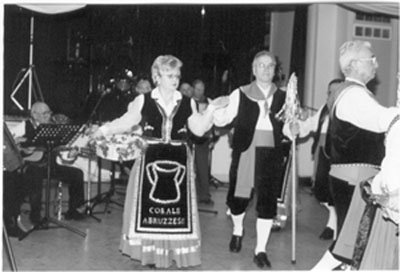|
|
| |
| Tarantella:
An Italian Folk Dance |
| By
Fiona Story |
| In
Italian culture, the word “tarantella” evokes images of
a frenzied spinning dance traditionally played at weddings. However,
this popular native dance of Southern Italy has a history and myth spanning
several centuries.
The dance, originally an Italian folk
dance of the lower- and middle-classes, has been labeled as a dance
to cure sickness and as a dance of courtship. In the courtship version
of the dance, the woman uses rapidity and liveliness to excite the
love of her partner. In turn, the man tries to charm her with his
agility, elegance and demonstrations of tenderness. The dance is one
of unity and separation, which sees dancers flying into each other’s
arms only to bound away again.
It is considered unlucky to dance the
Tarantella alone so it is often danced by couples or by two women. |
|
The
earliest historical mention of the Tarantella is the St. Vitus Dance
in 1374. It’s not mentioned again until 1839, as the title of
a ballet, “La Tarentule,” produced by Jean Coaralli. In
1844, Madame Michau introduced the dance to the public.
Three
possible sources of origin for the dance are given. The first originates
with the bite of the Tarantula, Arania or Apulcian Spider. The dance
itself was used to cure the poison from the bite of the spider. Town
folks would play music and the afflicted person would dance non-stop
to avoid succumbing to the poison. |
 |
| The
second origin lies in the religious story of the St. Vitus Dance,
which is commonly referred to as the outbreak of dancing in the Middle
Ages. The myth begins with the young people of Saxony dancing in the
churchyard of St. Magnus. Fifteen youths and four girls were dancing
and singing so loudly that they disturbed the priest. Angered, the
priest prayed to God and St. Magnus to make the youth dance for a
whole year. The outbreak of dancing went unexplained until the realization
that the dancers had been bitten by the Tarantula Spider.
The
final possible origin for the dance is said to be in the villages
of Toranto and Tarantum. Women working in the fields would use frenetic
dancing when they were bitten by spiders in order to sweat the venom
out through their pores.
The
Tarantella-type of dancing is not limited to just Italy. In Buzabatt,
Persia, there is a Tarantella dance which is similar to the one found
in Southern Italy. The Furlana or Fourlane found in Venice is also
similar to the Tarantella although it is more irregular and brusque
and danced mainly among gondoliers. The Saltarello in Rome and Venice
also bear some semblance to the Tarantella.
|
|
| back
to the top |
|

